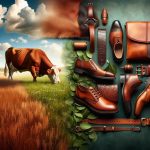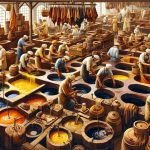I've always wondered why real leather is so expensive. Turns out, it's all about the cost of high-quality animal hides and the time-consuming craftsmanship involved. From cows to exotic alligators, the best skins aren't cheap, and neither are the skilled hands turning these hides into luxury items. Plus, methods like vegetable tanning which improve durability also add to the cost. Not to mention, the rarity and exclusivity of well-crafted leather goods just push the prices up even further. And with brands adding their mark-up, it's no surprise the costs soar. Stick around, and there's a whole lot more to uncover.
Table of Contents
Key Takeaways
- High-quality animal hides are scarce and expensive, especially exotic skins like alligator and crocodile.
- Skilled craftsmanship and time-intensive production processes elevate costs.
- The rarity and exclusivity of certain leathers increase their market value.
- Environmental impacts and sustainable practices in leather production can raise prices.
- Brand reputation and luxury market positioning often dictate higher pricing strategies.
Raw Material Costs
The high price of real leather starts with the costly animal hides required, like cow, goat, and lamb skins. It's not just about any old skin, though; we're talking top-notch quality hides here. These aren't easy to come by, and their scarcity pushes prices up. When you toss exotic skins like alligator and crocodile into the mix, the costs climb even higher. These luxury materials are rare and highly sought after, making them pricier than your average hide.
Now, it's not just the raw materials themselves but what needs to be done with them. Tanning processes, which are essential to transform rough animal skins into soft, durable genuine leather, also tack on to the expense. Different methods, like the eco-friendly vegetable tanning, can be more costly than traditional techniques. These methods aren't just about achieving that rich color and supple feel; they also impact the leather's quality and longevity.
Quality and Craftsmanship
When we look at why real leather is so pricey, we can't ignore the craftsmanship involved. It takes a lot of time and skilled hands to turn raw leather into something beautiful and durable.
Each piece reflects the care and expertise of the artisans who work with these precious materials.
Time-Intensive Production Processes
Crafting real leather takes a lot of time and skill, which really drives up its cost. The time-intensive nature of this process involves skilled artisans who put in hours of meticulous craftsmanship. Every step, from cutting to stitching, is a testament to their dedication to superior craftsmanship.
These aren't quick tasks; they're labor-intensive processes that require an expert level of precision. This isn't about rushing to meet production quotas; it's about taking the time to ensure each piece meets premium quality standards. The more time and effort poured into each piece, the higher the cost.
But trust me, when you hold a piece of finely crafted leather, you'll understand why it's worth every penny.
Skilled Artisan Techniques
Skilled artisans handcraft each leather piece with precision, ensuring both durability and elegance. This isn't just about making leather goods; it's about creating lasting art.
The labor-intensive nature of their work, combined with their high skill, makes each item a testament to expert craftsmanship. These artisans pour their hearts and skills into every stitch, which is why artisanal expertise is so crucial.
You're not just buying a product; you're investing in a piece of craftsmanship that holds up over time. The meticulous attention to detail required in leatherworking means it's both time and effort intensive.
That's why when you pick up a handcrafted leather item, you feel the quality instantly. It's all about the mastery behind the craft.
Material Source and Rarity
The quality and rarity of the animal hides used, such as those from cows, goats, lambs, and pigs, significantly drive up the cost of real leather. When you factor in exotic skins like alligator or crocodile, the price can skyrocket.
It's not just about the type of animal; the quality of the hide plays a massive part. Skilled artisans put in hours of meticulous work, turning these hides into luxury items. This expert craftsmanship isn't cheap. Every stitch and cut needs precision, which only seasoned pros can deliver.
Tanning Processes
Now, let's talk about how tanning processes affect leather's cost.
From traditional techniques that emphasize craftsmanship to modern innovations speeding things up, each method has its own impact on price and quality.
We also can't ignore the environmental concerns these processes bring up, making them a crucial part of the conversation.
Traditional Tanning Techniques
Many traditional tanning techniques, such as vegetable tanning, use natural materials and processes that contribute to the high cost of real leather. This method, revered for producing high-quality leather goods, demands extensive time and skilled labor.
Artisans meticulously utilize plant-based tannins, ensuring each piece's durability and unique aesthetic. The artisanal, eco-friendly nature of vegetable tanning not only aligns with sustainable practices but also adds to the allure and higher cost of the final product.
Crafting leather through these traditional tanning methods involves a level of craftsmanship unmatched by quicker, less labor-intensive techniques. The outcome? Exceptional leather that justifies its price, appealing especially to those who value quality and sustainability.
Modern Tanning Innovations
Shifting focus to modern tanning innovations, we see technologies that make leather production both more efficient and sustainable. These advancements aren't just cool tech gimmicks; they're crucial for upping the quality of leather while dialing down our environmental footprint.
Take water-based tanning, for instance—it slashes the chemical load, making the process cleaner and greener. These improved techniques also boost the leather's durability and feel, ensuring that the products last longer and perform better.
Although these innovations do hike up the cost, they're a worthy investment for the sake of sustainability. The shift to more responsible production methods reflects a broader commitment to environmental responsibility in the leather industry.
Environmental Impact Concerns
While modern innovations have improved the sustainability of tanning, the environmental impacts of these processes remain a significant concern. I've learned that opting for environmentally friendly methods like vegetable tanning isn't just a trend; it's driven by serious ethical considerations. These techniques, though costly, play a crucial role in sustainable production.
They ensure less harm to our environment but, as you might guess, they also lead to higher production costs. It's a trade-off. If we prioritize the environment, we've to be ready to pay a bit more. Every step taken towards reducing the environmental impact concerns in tanning is essential, but these steps come with their own price tags, reflecting in the cost of real leather.
Labor Intensity
The labor-intensive nature of leather production, requiring skilled artisans, significantly drives up its cost. When you think about making leather goods, it's not just a matter of stitching pieces together. Each item is handcrafted with meticulous attention to detail. This precision isn't something you rush. It demands a lot of time and effort, which naturally bumps up the price.
These skilled artisans aren't your everyday workers; they're craftsmen with years of training under their belts. Their expertise is crucial, not only for creating beautiful pieces but also for ensuring durability and functionality. This level of skilled labor is a major factor in the hefty price tag of real leather products.
Moreover, because each piece is handcrafted, the production process isn't just slow—it's costly. Think about it: more hours of work means more wages to pay. And this isn't assembly line work; each artisan's contribution is unique and irreplaceable, adding to the overall production costs.
Environmental Impact
Leather production's hefty water and chemical use significantly impacts the environment. The traditional leather tanning processes aren't just old school; they're major contributors to environmental degradation. It's clear that every step in the making of traditional leather can potentially harm our planet.
Here are some key issues:
- Water Pollution: The chemicals used in tanning, like chromium and other solvents, end up in nearby water sources, harming aquatic life and local communities.
- Deforestation: Large swathes of land are cleared for cattle farming, leading to loss of biodiversity and increased carbon emissions.
- Eco-Friendly Leather Production: Options exist that use natural dyes and more sustainable practices, aiming to mitigate these environmental impacts.
To me, understanding the environmental impact of leather production deepens when considering the shift towards sustainable practices. Eco-friendly leather production isn't just a trend; it's about responsible sourcing and genuinely caring for the environment. This shift is fueled by consumers demanding products that align with their values of conservation and responsibility. It's about making sure that while we enjoy quality leather goods, we aren't compromising the health of our planet. It's a complex balance, but vital for sustainability.
Import and Export Taxes
Now, let's talk about the taxes that affect the cost of real leather.
Global tariff variations mean that the price of leather can swing wildly depending on where it's coming from or going to.
Plus, trade agreements and compliance with different countries' regulations pile on more costs that manufacturers pass down to us, the buyers.
Global Tariff Variations
Understanding how import and export taxes affect leather prices worldwide is crucial for any business dealing in real leather goods. The nuances of international trade, particularly import tariffs and taxes, can drastically shift pricing competitiveness in the global market.
Here's what you need to grasp:
- Import taxes can hike up the costs drastically, impacting how affordable real leather is across different markets.
- Countries with high tariff rates often see pricier leather products, affecting consumer buying power.
- Tariff policies determine the flow and feasibility of leather goods in international markets, influencing overall business strategies.
Grasping these elements helps in navigating the complex terrain of selling and buying real leather globally, ensuring one stays competitive and informed.
Trade Agreements Impact
Trade agreements directly shape the costs we see in the real leather market by altering import and export taxes. When a country slaps high import taxes on raw materials like animal hides, it bumps up production costs for manufacturers. They've got to pay more to get what they need, which means we end up paying more for that final leather product.
On the flip side, export taxes on finished goods can jack up the price tags we see in stores. These tariffs are part of a complex cost structure that affects the global market for leather. Understanding how these trade agreements play out helps us get why real leather is such a pricey material.
Regulatory Compliance Costs
Building on how trade agreements affect leather costs, let's look at another significant factor: regulatory compliance costs like import and export taxes. These can really bump up the price we pay for real leather. Here's a quick rundown to keep things crystal clear:
- Import Taxes and Duties: Depending on where it's coming from, leather can face steep tariffs, making it more expensive right from the get-go.
- Export Taxes: Sending raw materials out can be costly too, thanks to taxes on exports, which can limit supply and push up prices.
- Regulatory Variations: Different standards across countries mean the compliance costs aren't uniform, adding another layer to the production costs puzzle.
All these factors combine to make real leather a premium product.
Rarity and Exclusivity
Real leather's high cost often stems from its rarity and the exclusivity of materials like alligator and ostrich skins. When you're dealing with exotic leathers, you're not just paying for any old piece of material; you're investing in rare leathers that aren't easy to come by. The scarcity of these materials is no joke. Finding top-grade hides, especially from exotic animals, can be a challenge. It's not like these skins are just lying around waiting to be picked up and turned into luxury goods.
This scarcity plays a huge role. Since these rare leathers are in such high demand, especially from luxury brands, the prices naturally shoot up. You've got a classic case of limited supply and eager demand bumping up the cost. Plus, the exclusivity of real leather isn't just about how hard it's to find these hides. It's also about the craftsmanship involved. Working with such high-quality materials requires a level of skill and expertise that not every craftsman possesses. This expertise adds another layer of exclusivity to the mix, ensuring that products made from these leathers aren't just common goods, but true pieces of art.
Market Demand Dynamics
While the rarity of real leather sets its high price, it's also the ever-changing market demand that keeps those prices soaring. As someone deeply interested in why things cost what they do, I've realized that understanding market dynamics is key to grasping why genuine leather remains a premium product. Here are a few pivotal factors:
- Consumer Preferences: Trends in fashion significantly influence the demand for genuine leather. When vintage or rustic styles become popular, demand spikes, hiking up prices.
- Luxury Brands: High-end designers often dictate market trends. Their use of high-quality leather goods in collections can drive up demand across the industry.
- Economic Factors: The overall economic climate, including consumer purchasing power, directly impacts how much people are willing to spend on luxury items like real leather.
Luxury brands leverage these dynamics with savvy pricing strategies to maintain the allure and exclusivity of their products. The competition among these brands doesn't just push the boundaries of design but also impacts how leather types are priced and perceived in the market. It's a fascinating interplay of desire and availability that keeps genuine leather at the pinnacle of fashion must-haves.
Types of Leather
Let's dive into the different types of leather and see why some are pricier than others. Full grain leather sits at the top of the luxury scale. It retains the natural grain and is highly durable, making it a favorite among luxury brands for products that boast both quality and longevity. When you touch a full grain leather bag, you're feeling the real deal, and it's often why these items come with a hefty price tag.
On the flip side, bonded leather and genuine leather are on the lower end of the spectrum. These are the types you'll often find in cheaper alternatives at high street fashion stores or in budget furniture. Genuine leather, despite its name, is actually not the highest quality—it's made from leftover scraps bonded together. Bonded leather is even less pure, often mixed with synthetic materials.
For those ultra-exclusive items, luxury brands might opt for exotic leathers or calf leather. Exotic leathers, like ostrich, add an unusual texture and pattern, which screams uniqueness and ramps up the cost. Calf leather, meanwhile, is prized for its softness and fine grain, making it perfect for high-end goods where touch and aesthetic are paramount.
Dyes and Color Costs
Diving deeper into why leather products can be pricey, let's explore how the choice of dyes and colors influences costs. The process of coloring leather isn't just a dunk into a dye vat; it's a nuanced art that significantly impacts the price tag.
Here are a few key points to consider:
- Fully Dyed Leathers: These leathers undergo an extensive dyeing process to ensure the color permeates throughout, not just on the surface. This method requires more dye and time, hiking up the production costs.
- Hand-Antiqued Leathers: Unlike their machine-sprayed counterparts, these leathers are treated by skilled artisans who manually apply and rub in dyes to create a unique, aged look. This labor-intensive process means higher costs.
- White Leather: Achieving that crisp, uniform color in white leather is notoriously difficult. It demands precision and extra care during the dyeing process, leading to higher color costs and a steeper price for the end product.
Understanding these aspects helps to appreciate why a simple color change can transform the price of leather goods. It's not just about aesthetics; it's about the intricate efforts and resources that go into creating that perfect hue.
Scale of Production
When we look at the scale of production, it becomes clear why real leather is so costly. The whole process starts with the limited availability of animal hides. You can't just ramp up production on a whim; these hides depend on the natural growth and availability of livestock, which can't be hurried. This limited supply sets the stage for everything else.
Then there's the tanning process. It's not something you rush. It requires a ton of skilled labor and some pretty specific equipment. Each of these factors ramps up the production costs significantly. Because of the expertise needed and the time it takes, you end up with a product that's not just durable but also costly.
And let's not forget about the demand for real leather goods. High demand with a restricted supply? That's a classic recipe for price fluctuations. When more folks want a piece of the pie than the pie can provide, prices are bound to go up.
Brand Influence
Moving beyond production, the influence of well-established brands also significantly elevates the cost of real leather. When we dive into why genuine leather costs a pretty penny, the brand influence can't be overlooked. It's not just about the material; it's about the entire legacy and reputation that comes with it.
Here's why brand influence matters so much:
- Heritage and Reputation: Brands with a long history and solid reputation often charge more. They've built trust over generations, and people are willing to pay for that assurance.
- Brand Value: Investment in research and development by these brands ensures top-notch quality. This not only justifies but also adds to the premium pricing of their leather goods.
- Customer Satisfaction: High customer satisfaction leads to repeat buyers and strong word-of-mouth, allowing brands to maintain higher prices.
The pricing strategy for genuine leather items is deeply entwined with the brand reputation. If a brand is recognized for its quality and reliability, their leather products are seen as investments rather than mere purchases. This perception allows brands to set and maintain higher price points, ensuring that customer satisfaction remains high while fostering a sense of exclusivity and desirability around their products.
Frequently Asked Questions
Is Genuine Leather Worth the Money?
I definitely think genuine leather is worth the money. It's durable, ages well, and looks luxurious. Plus, the craftsmanship and customization options add a unique, personal touch that's hard to beat.
Is 100% Genuine Leather Good?
I think 100% genuine leather is great! It's durable, ages beautifully, and adds a touch of luxury. Since it lasts so long and looks better over time, I believe it's a worthwhile investment.
How Much Does Real Leather Cost?
Real leather costs vary widely, often due to the quality and tanning methods used. I've seen prices range from moderately expensive to extremely high, especially for premium types like full grain leather.
Which Is Better Real Leather or Genuine Leather?
I'd say real leather is better than genuine leather because it's more durable, ages well, and offers a luxurious feel that justifies its higher cost, especially if you're looking for long-term value.
- Eco-Friendly Fabric Care: Top Tips - July 24, 2024
- The Best Tools and Products for Fabric Care - July 24, 2024
- Extending the Life of Your Fabrics: Tips and Tricks - July 24, 2024








